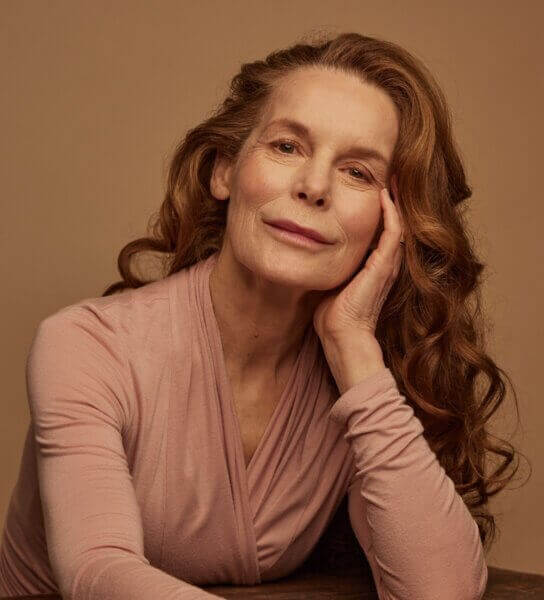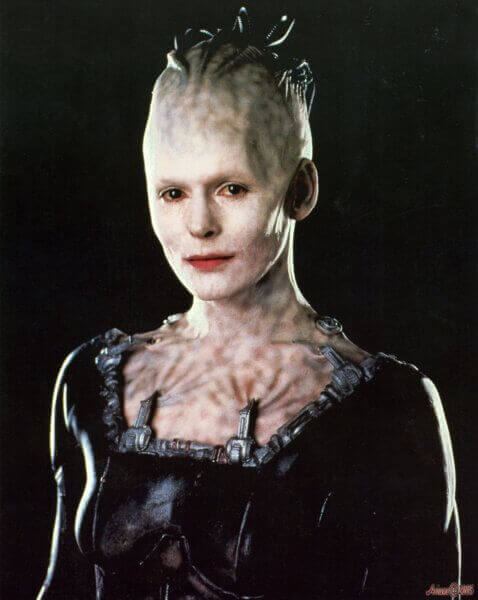By her own admission, Alice Krige (pronounced “Kree-guh”) leads a very sheltered life.
“I’m either on a film set or I’m home – I love that,” said Krige, of England, perhaps best known for 1981’s Chariots of Fire and 1996’s Star Trek: First Contact.
She continued: “When I’m not working, I tend to lead a quiet life by choice. I come home and I’m very happy to be home – it’s restorative and grounding.”
So, to attend conventions is quite an eye-opening experience.
“I meet an astonishing range of people – people I’d never meet in the ordinary course of my life,” said Krige, who’s making her debut at Motor City Nightmares in Metro Detroit over the weekend of July 29-31.
Born in South Africa, Krige is the youngest of three and the only female. She grew up without television since South Africa didn’t get television until 1976. An alumna of Rhodes University in Grahamstown, South Africa, Krige later joined the Royal Shakespeare Company in England.
Acting Alongside Hollywood Legends
She made her film debut in 1976’s Vergeet My Nie. Her second film was 1981’s Ghost Story, based on horror author Peter Straub’s 1979 novel of the same name. It was the last film to feature classic Hollywood actors Fred Astaire (Shall We Dance), Melvyn Douglas (Hud), and Douglas Fairbanks, Jr. (Gunga Din). Krige played the ghost of a woman killed by four elderly businessmen.
“It was fascinating to play magical incarnations of the same character,” she said. “You meet her as Eva Galli, then you meet her as Alma Mobley, then she appears as an apparition… I found that very, very fascinating when I read the script.”
Krige has fond memories of working with the aforementioned actors, as well as John Houseman (The Paper Chase) and Patricia Neal (Breakfast at Tiffany’s).
“They were extraordinary, all of them. There was a gallantry I rarely encountered since. They were consummate professionals. They had a lightness and a humor that was absolutely beguiling. They were polite to everyone. They were totally prepared,” she recalled. “I knew I was in the presence of something absolutely unique and quite remarkable. They were quite exceptional, extraordinary role models to aspire to.”
They stayed at the Gideon Putnam in Saratoga Springs, NY while filming.
“Every night, we ate (dinner) in the hotel together,” said Krige. “I enjoyed listening to the banter between them and all the stories they told about their Hollywood exploits. It was extraordinary – an experience never to be repeated. I felt extraordinarily privileged and blessed to have it.”
Krige next appeared in the aforementioned Oscar-winning Chariots, which chronicled the story of two British athletes in the 1924 Olympics: Eric Liddell (Ian Charleson, Gandhi) and Harold Abrahams (Ben Cross, A Bridge Too Far). Krige played opera singer Sybil Gordon, Abrahams’ fiancée.
“It was a lovely, wonderful script. Very inspirational script. Sybil was a real person, which I felt was a huge responsibility. The researchers were in touch with Abrahams’ children. I asked to meet the son (who) gave me a little box with her possessions and said, ‘You can keep this for the duration of the shoot.’ That made it very, very personal and special. Whenever I went to set, I took Sybil’s box with me… I met my husband (director/writer Paul Schoolman, Jail Caesar) on (Chariots). I was floating around on a cloud of love,” Krige said, laughing. “It was a rather wonderful experience in every possible way.”
“I Bring Order to Chaos”
With the exception of “Beam me up, Scotty,” Krige confessed to not knowing anything about the Star Trek franchise when she auditioned for the Borg Queen – for which she won a Saturn Award – in First Contact. The Borg, best known for its ominous catchphrase “Resistance is futile,” is a race of cyborgs linked to a hive mind called the Collective. They assimilate entire races and transform them into drones – something they did to Capt. Jean-Luc Picard (Patrick Stewart) on Star Trek: The Next Generation‘s “The Best of Both Worlds” episodes. The Borg Queen is the focal point within the Borg’s collective consciousness, personifying their overall intelligence, bringing “order to chaos.”
“What interested me is the enigma of just who she is. It’s really hard to fathom exactly who and what she is. She was very interesting to play… a character who’s so utterly convinced of her correctness,” explained Krige. “She assimilates people against their will and makes them her drones. She steamrolls over people. Anything she wants, she takes – that’s disturbing. Yet there’s something about her that was very empowering. Oddly enough, I think people experience enormous ambivalence in relation towards the character because in some ways she was very attractive to people. People found her attractive and, in equal measure, repulsive and frightening. There’s this dissonance the character created in viewers.”
Krige reprised her role on the series finale of Star Trek: Voyager, the 2004 short film Star Trek: The Experience – Borg Invasion 4D, and last year on the animated series Star Trek: Lower Decks (although it was “very light-hearted and tongue-in-cheek”). Krige’s fascinated by the Borg Queen’s popularity.
“I had no idea if (the creators) realized what an archetype they were creating,” said Krige. “She’s a receptacle for people’s disquiet – whatever disturbs someone or whatever they find difficult to cope with – she seems to embody that in one way or another, whether it’s A.I. or mechanization or sexuality – she seems to mean something quite distinctive to each individual who encounters her. I don’t know if anyone thought she’d become so resonant.”
Krige had an “enormous amount” of fun working with Stewart, Brent Spiner (Data), and director Jonathan Frakes (Cmdr. William Riker).
“Everyone was so keen for the film to work because it was Jonathan’s first big feature,” she said. “Everyone went above and beyond. It was very special because everyone so badly wanted it to succeed – and it did. It does stand alone as a piece of science-fiction; you don’t have to know (Trek) to appreciate it.”
Where There’s a Will…
Other notable roles include 2000’s The Little Vampire, 2002’s Reign of Fire, 2005’s Dynasty: The Making of a Guilty Pleasure (as actress Joan Collins), 2006’s Silent Hill, 2009’s Solomon Kane, 2010’s The Sorcerer’s Apprentice, 2013’s Thor: The Dark World, and Netflix’s The Christmas Prince movies.
She spoke about playing Collins.
“It was a feat of engineering to attempt to get me to look anything like her at all. My waist was cinched in; I was wearing a pushup bra, a wonderful wig, and a great deal of makeup. It was great – it was lighthearted and a good experience and a social observation of the Reagan era.”
Krige never met Collins.
“I have no idea whether she was mortified or amused,” she said.
With Schoolman and producer/writer Dimitrios Katsantonis (Echoes of the Past), she’ll star in the upcoming films The Arcade, Three Widows, and Naked Abuse. This marks Krige’s first time producing.
“It’s an enormous challenge I greatly enjoy,” she said.
Alongside fellow Trek villain Malcolm McDowell (who killed William Shatner’s Capt. James T. Kirk in 1994’s Star Trek: Generations), Krige will star in She Will. Krige plays a woman who goes to a healing retreat in Scotland after a double mastectomy. It turns out the retreat is the site where women believed to be witches were burned at the stake.
“It’s actually more of a psychological thriller – more drama, more supernatural than straight horror,” she explained. “(Director) Charlotte Colbert (The Silent Man) brings a very unique artist’s sensibility to the look and feel of the film. Visually, it’s very striking and has an amazing score that becomes a character in the piece – it has a very powerful presence. It’s an unusual film that weaves together a multitude of strands that somehow weave the tapestry and tell a story.”








